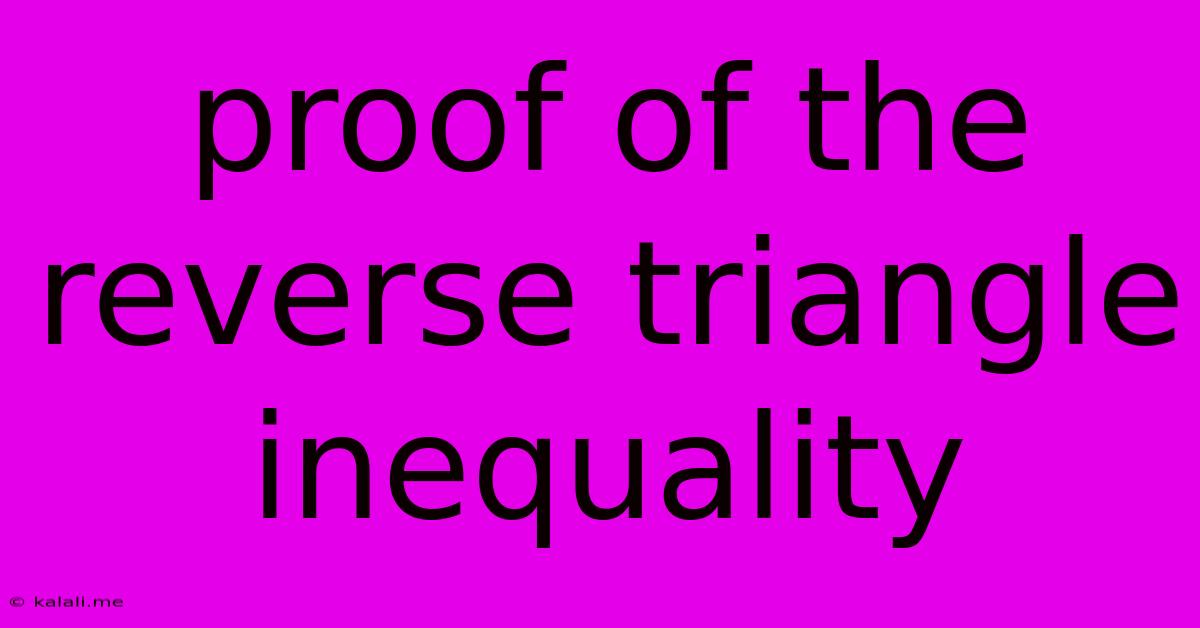Proof Of The Reverse Triangle Inequality
Kalali
May 25, 2025 · 2 min read

Table of Contents
Proof of the Reverse Triangle Inequality
The reverse triangle inequality, a crucial concept in mathematics, particularly within the realm of metric spaces and vector spaces, provides a lower bound for the magnitude of the difference between two vectors or numbers. It's a powerful tool with applications ranging from numerical analysis to theoretical physics. This article will present a clear and concise proof of this inequality, along with a discussion of its implications.
What is the Reverse Triangle Inequality?
The reverse triangle inequality states that for any two vectors or numbers, a and b, the following inequality holds:
| ||a|| - ||b|| | ≤ ||a - b||
where ||.|| denotes the norm (or magnitude) of the vector or number. This inequality essentially says that the absolute difference between the magnitudes of two vectors is always less than or equal to the magnitude of their difference.
Proof of the Reverse Triangle Inequality
We can prove the reverse triangle inequality using the standard triangle inequality, which states:
||a + b|| ≤ ||a|| + ||b||
Let's start by applying the triangle inequality to vectors a and b:
-
||a|| = ||a - b + b|| ≤ ||a - b|| + ||b|| (Applying the triangle inequality to a - b and b)
-
Rearrange the inequality: Subtracting ||b|| from both sides, we get:
||a|| - ||b|| ≤ ||a - b||
Now, let's switch the roles of a and b:
-
||b|| = ||b - a + a|| ≤ ||b - a|| + ||a|| (Applying the triangle inequality to b - a and a)
-
Rearrange the inequality: Subtracting ||a|| from both sides and noting that ||b - a|| = ||a - b||, we have:
||b|| - ||a|| ≤ ||a - b||
-
Combining the inequalities: From steps 2 and 4, we have:
||a|| - ||b|| ≤ ||a - b|| and ||b|| - ||a|| ≤ ||a - b||
These two inequalities can be combined using the absolute value function:
| ||a|| - ||b|| | ≤ ||a - b||
This completes the proof of the reverse triangle inequality.
Implications and Applications
The reverse triangle inequality provides valuable insights into the relationship between vector magnitudes and their differences. Its applications are widespread:
- Error analysis: In numerical analysis, it helps bound the error in approximations.
- Metric spaces: It's fundamental in defining properties of metric spaces, ensuring that the space satisfies the necessary axioms.
- Functional analysis: It plays a key role in various theorems and proofs within functional analysis.
- Physics: Applications exist in areas like quantum mechanics and classical mechanics where vector magnitudes represent physical quantities.
Conclusion
The reverse triangle inequality, derived elegantly from the standard triangle inequality, is a cornerstone result in mathematics with numerous practical applications across diverse fields. Its proof, as demonstrated above, is straightforward yet powerful, highlighting the interconnectedness of fundamental mathematical concepts. Understanding this inequality provides a deeper appreciation for the structure and properties of vector spaces and metric spaces.
Latest Posts
Latest Posts
-
Is Tomato Sauce And Tomato Puree The Same
May 25, 2025
-
What Gauge Wire Do I Need For 20 Amps
May 25, 2025
-
How Long Can Salmon Sit Out
May 25, 2025
-
I Would Love Too Or To
May 25, 2025
-
How Do You Clean The Jets In A Whirlpool Tub
May 25, 2025
Related Post
Thank you for visiting our website which covers about Proof Of The Reverse Triangle Inequality . We hope the information provided has been useful to you. Feel free to contact us if you have any questions or need further assistance. See you next time and don't miss to bookmark.